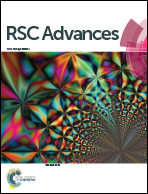Removal of As(iii) from water using modified jute fibres as a hybrid adsorbent†
Abstract
Many studies have concentrated on the removal of arsenic from water using granular mineral fine particles. However, very little research has focused on the preparation of materials which aim to be applied to the situations of arsenic pollution emergencies in rivers or lakes. In this study, jute fibres were modified by loading iron oxyhydroxide (which was demonstrated to be mainly α-FeOOH) to produce an effective hybrid adsorbent (Fe-JF) with the advantages of an excellent arsenic removal effect and easy retrieval from rivers or lakes. The jute fibres were firstly esterified with succinic anhydride to graft with carboxyl groups in order to enhance the loading amount of iron(III), the maximum iron(III) loading on Fe-JF reached 208.2 ± 0.2 mg g−1 while the density of grafted carboxyl groups was 2.78 mmol g−1. The maximum adsorption capacity for As(III) reached 12.66 mg g−1 while the density of carboxyl groups was 2.21 mmol L−1. Meanwhile, the iron leaching amount was 0.178 mg L−1 which could meet the requirement of the standard limit of iron in drinking water (China, 0.3 mg L−1). Influential factors, such as pH, contact time and coexisting anions are investigated in this study. The column experiments showed that the breakthrough point declined from 2300 BV (bed volume) to 1200 BV when EBCT (empty-bed contact time) decreased from 3.5 min to 1.8 min. The Adams–Bohart model was adopted to describe the continuous flow system.


 Please wait while we load your content...
Please wait while we load your content...